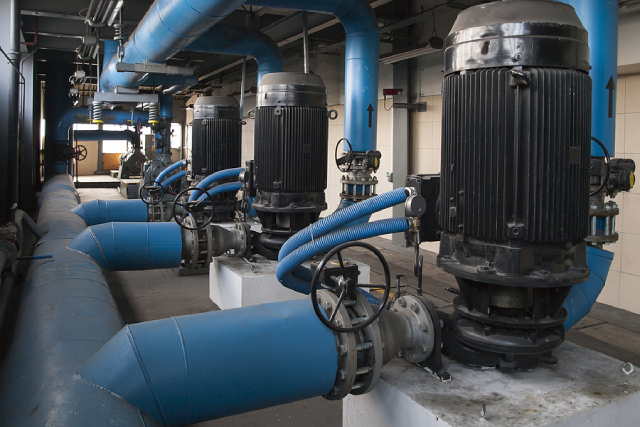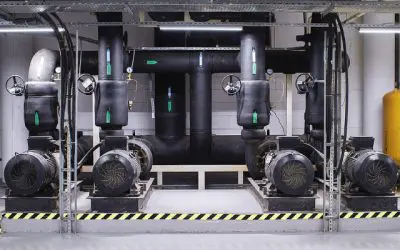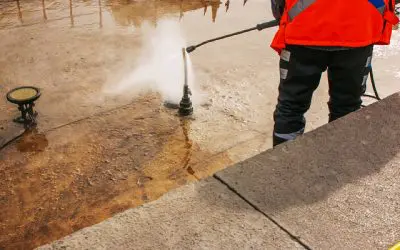
ANSI pumps are an integral asset in many industrial facilities that need to move vast volumes of fluids reliably day after day and keep production running without interruption. But as with every other machine on the floor, these pumps also have a finite lifespan. The question for many plant managers and engineers is not if the pump will fail, but when.
Recognising the early signs of decline is crucial to avoid sudden breakdowns, optimise costs, and maintain operational safety. Many assume that repairing a pump is always the more economical route, but that’s not always the case. According to the non-profit Hydraulic Institute, the initial purchase price of an industrial pump only represents around 10% of its total lifecycle cost over the average 15 to 20 years that it remains in service. The rest stems from energy consumption, maintenance, downtime, and installation.
When these secondary costs begin to rise, replacement often becomes the smarter long-term investment. If your facility relies on older units, switching to a high-efficiency pump could yield significant savings in both energy and maintenance over time.
Below are five clear warning signs that your ANSI pump might be approaching the end of its serviceable life and why replacing it may be the most cost-effective move.
1. Efficiency Losses Start Draining Your Profits
Efficiency degradation often goes unnoticed until it starts impacting your bottom line. Unlike catastrophic failures, it creeps in slowly, sapping performance and increasing operational costs without immediate symptoms.
Studies show that pump efficiency can degrade by as much as 10% to 25% before replacement, with some units running at efficiencies as low as 50% to 60%. The primary causes include:
- Increased internal clearances as wear rings and impellers erode
- Surface roughness due to corrosion, erosion, or cavitation
- Altered hydraulic geometry from wear or deposit buildup
As these conditions worsen, hydraulic efficiency drops. For example, when internal clearances double (which is a common scenario in ageing pumps) efficiency can plummet below design specifications, costing thousands in unnecessary energy use.
How to Evaluate Efficiency Losses
- Conduct field performance testing to measure actual flow, head, and power usage
- Compare current efficiency to original factory specifications
- Assess operation relative to the Best Efficiency Point (BEP)
- Measure internal clearances during maintenance inspections
- Perform a cost-benefit analysis between continued operation and replacement
If performance testing shows your pump operating far from its BEP or below expected efficiency thresholds, it’s a strong indicator that replacement should be considered.
2. Recurring Mechanical Seal Failures
Mechanical seals are among the most common failure points in an ANSI pump for application across industrial systems, responsible for up to half of all reported breakdowns. While occasional seal replacements are part of routine maintenance, frequent failures suggest deeper mechanical issues that can’t be resolved through simple repairs.
It’s normal for seals to allow a controlled level of leakage to maintain lubrication. However, excessive leakage signals that your pump’s mechanical tolerances are no longer within safe limits. According to ANSI/ASME B73.1 standards, shaft deflection at the seal face should not exceed 0.002 inches. Once bearings, shafts, or seal chambers wear beyond this, maintaining proper seal contact becomes impossible.
Excessive leakage wastes resources and, more importantly, can create serious safety risks, especially when handling flammable or hazardous fluids. Prolonged operation under these conditions increases downtime, risk, and total repair costs.
How to Check for Mechanical Seal Failures
- Track seal failure frequency and modes; monitor Mean Time Between Failures (MTBF)
- Measure shaft runout at the seal face using a dial indicator
- Inspect for signs of cavitation, dry running, or misalignment
- Ensure proper environmental controls, such as cooling or flushing plans
- Examine seals for uneven wear, burn marks, or discolouration
If seals are failing more frequently despite proper maintenance and operating conditions, it’s often a sign that your pump’s internal geometry has degraded beyond economic repair.
3. Multiple Worn Components Increase Repair Costs
A single worn part may not warrant a full replacement, but when multiple components degrade at once, repair costs can quickly spiral. Bearings, wear rings, shafts, and impellers all have finite tolerances, and when several reach their limits simultaneously, the economics shift sharply toward replacement.
Manufacturers often cite the “50% Rule”: if repairs cost more than half the price of a new pump, replacement is the more economical choice. For ANSI pumps, that threshold can drop to around 40% because of their standardised design and competitive market pricing.
Beyond cost, multiple worn components can cause cumulative efficiency losses, unplanned downtime, and diminished reliability. Continuing to run a degraded system can also accelerate damage to newer parts, creating a vicious cycle of maintenance.
Performing an energy audit in Singapore, for instance, can provide a clear view of how much inefficiency is costing your operation and how much you could save by upgrading to newer, more efficient equipment.
How to Evaluate Overall Wear
- Document components exceeding manufacturer wear limits during disassembly
- Calculate total repair costs, including labour
- Review historical maintenance data for repair frequency
- Assess how component wear impacts performance and reliability
If several core components show excessive wear, it’s usually more prudent to invest in a modern replacement than to risk further degradation and downtime.
4. Persistent Vibration Despite Repairs
All rotating equipment generates vibration, but excessive or persistent vibration is a red flag that shouldn’t be ignored. The ANSI/HI 9.6.4 standard outlines acceptable vibration limits based on pump power rating and defines alert, alarm, and shutdown thresholds.
When vibration persists despite balancing, alignment, or bearing replacement, it typically points to structural or internal mechanical problems such as:
- Impeller damage or imbalance
- Shaft deformation beyond repairable limits
- Foundation or baseplate deterioration
- Bearing housing damage
- Resonance issues within the structure
Unchecked vibration accelerates wear across all components—bearings, seals, impellers, and piping. It can even induce fatigue in adjoining systems, increasing maintenance frequency and the risk of secondary failures.
How to Assess Persistent Vibration
- Measure vibration at bearing housings along horizontal, vertical, and axial axes
- Compare readings to ANSI/HI 9.6.4 vibration limits
- Use spectrum analysis to pinpoint root causes
- Check for structural resonance conditions
- Track vibration trends over time
When vibration levels exceed alarm limits or rise steadily despite repeated maintenance, it’s usually more cost-effective to replace the pump entirely.
5. Casing Damage That Compromises Structural Integrity
The pump casing is its backbone and once compromised, there’s little that repairs can safely achieve. As the most expensive single component, the casing often determines the pump’s total lifespan.
ANSI B73.1 pump casings are designed with strict pressure containment standards, typically incorporating a corrosion allowance of around 3.2mm (1/8 inch). Once material loss exceeds this limit, safety margins drop sharply.
Signs of structural casing failure include:
- Wall thickness below the minimum safe levels
- Through-wall cracks or fissures
- Severe erosion is altering internal flow paths
- Mounting surface distortion
- Bolt hole elongation or thread damage
Casing damage not only poses safety hazards but also risks catastrophic system failure. Once structural integrity is compromised, replacement is the only responsible option.
How to Inspect Casing Condition
- Conduct hydrostatic pressure testing in line with ANSI/HI 14.6 standards
- Perform ultrasonic thickness testing on key stress areas
- Use dye penetrant testing to detect surface cracks
- Inspect bolt holes, gasket surfaces, and mounting flanges for distortion
When casing deterioration reaches this stage, replacing the pump becomes a safety imperative.
Conclusion
Your ANSI pump has likely served faithfully for years, but even the most reliable equipment reaches a point where repairs no longer make sense. Replacing an ageing ANSI pump may seem like a significant upfront cost, but the long-term benefits far outweigh the short-term savings of continued repair. So, keep an eye out for the warning signs explored above to ensure you can act at the right time and keep operations efficient, safe, and future-ready.



